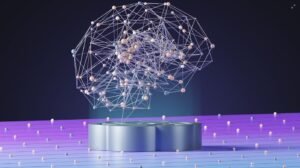Deepfake: What Is It?
Deepfake technology is an artificial intelligence-based technique used to create or alter images, videos, or audio content to depict events that did not actually occur, often using existing footage from various sources. It has gained attention in recent years due to its potential for fraudulent activities and manipulation of public opinion. Deepfake combines deep learning algorithms with facial mapping and synthesis to generate highly realistic and convincing counterfeit media.
Key Takeaways
- Deepfake is an AI technology that creates synthetic media, which can be used to manipulate or fabricate content.
- It uses deep learning algorithms to analyze and manipulate existing images or videos to generate realistic but false content.
- Deepfake poses ethical concerns and challenges to privacy, security, and trustworthiness of media.
- Legal measures and technological advancements are being developed to detect and combat deepfake content.
Understanding How Deepfake Works
Deepfake technology utilizes deep learning algorithms, specifically generative adversarial networks (GANs), to analyze and learn from large datasets of images or videos. These algorithms then enable the creation of synthetic media by blending and manipulating the facial features and movements of individuals in existing footage.
The process involves two main steps:
- Training: Deepfake algorithms are trained using thousands of images or videos of the target individual to learn their facial characteristics, expressions, and mannerisms, thereby creating a “fake” dataset.
- Generation: Once trained, the algorithm can analyze real footage and seamlessly replace the face of the target individual with the synthesized facial movements and expressions generated from the “fake” dataset.
*Deepfake technology’s ability to generate highly realistic content has raised concerns about the potential for misinformation and manipulation.
The Potential Impact on Society
Deepfake technology presents both challenges and risks in various aspects of society:
- Political Manipulation: Deepfakes can be used to create videos or audio clips that appear to show political figures saying or doing things they never said or did, causing public confusion and potentially influencing elections.
- Spread of Fake News: Deepfakes can be used to create false information or manipulate news stories, making it increasingly difficult for people to discern between genuine and fabricated content.
- Privacy Invasion: Deepfake technology raises concerns about privacy, as individuals’ faces can be superimposed onto explicit or compromising videos without their consent.
*Deepfake technology has the potential to disrupt public trust and provoke social unrest.
Deepfake Detection and Mitigation
Efforts are being made to detect and combat the spread of deepfake content:
- Forensic Analysis: Advanced algorithms are being developed to analyze and detect inconsistencies or subtle artifacts that indicate the presence of deepfake manipulation.
- Verification Technologies: Digital watermarking and cryptographic verification techniques are being explored to ensure the authenticity of media content.
*The development of detection and mitigation techniques is an ongoing process, as deepfake technology evolves and becomes increasingly sophisticated.
Interesting Data Points:
| Year | Estimated Number of Deepfake Videos |
|---|---|
| 2017 | 7,964 |
| 2018 | 14,678 |
| 2019 | 96,432 |
Current Efforts Against Deepfake:
- Legislation: Governments worldwide are considering or implementing laws and regulations to tackle deepfake technology, including criminalizing malicious use.
- Public Awareness and Education: Organizations and media outlets are working to raise awareness about deepfake technology and its potential impact, aiming to educate individuals on how to identify and prevent the spread of manipulated content.
Conclusion
Deepfake technology has the potential to disrupt various aspects of society, from politics to personal privacy. Detecting and mitigating deepfake content remains an ongoing challenge as creators continuously adapt and improve their techniques. Maintaining awareness and skepticism when consuming media will be crucial in navigating the era of deepfakes.

Common Misconceptions
Deepfake: What Is
When it comes to deepfake technology, there are several common misconceptions that people tend to have. It is important to separate fact from fiction in order to fully understand the implications and potential dangers associated with this emerging technology.
Misconception 1: Deepfakes are only used for nefarious purposes.
- Deepfakes can indeed be used for malicious activities, such as creating fake celebrity pornographic videos.
- However, deepfake technology also has legitimate applications, including in the entertainment and advertising industries.
- It is essential to not categorize all deepfake use as malicious, as there are instances where it can bring value and entertainment.
Misconception 2: Deepfakes are always easy to spot.
- While some deepfakes still exhibit noticeable flaws, advancements in artificial intelligence have made it difficult to distinguish between real and manipulated content.
- Deepfake algorithms continuously improve, making it much harder for the average person to detect any manipulation.
- As deepfake technology progresses, it is essential to stay vigilant and develop reliable detection methods.
Misconception 3: Deepfake technology only creates convincing videos.
- Although deepfakes are often associated with videos, it is important to note that this technology can also manipulate images, audio recordings, and text.
- With deepfake audio, for example, someone’s voice can be manipulated to sound like someone else, potentially leading to instances of identity fraud or misinformation.
- By understanding the diverse range of media that can be manipulated, we can better protect ourselves from the potential harm caused by deepfake technology.
Misconception 4: Legislation alone can solve the deepfake problem.
- While laws and regulations are important to combat the misuse of deepfake technology, relying solely on legislation is not enough.
- As the technology evolves rapidly, law enforcement agencies and governments face significant challenges in keeping up with its advancements.
- It is crucial for individuals, organizations, and technology companies to actively develop and implement detection tools and educate the general public about deepfakes and their potential consequences.
Misconception 5: Deepfakes only affect celebrities and public figures.
- While deepfakes featuring famous individuals may receive more media attention, anyone can become a victim of targeted deepfake manipulation.
- From revenge porn to fake news, the potential impact of deepfakes on personal and public life is vast.
- It is important for individuals to be aware of the risks associated with deepfake technology and take precautions to protect themselves online.

Table Title: Examples of Deepfake Technologies
Deepfake technologies utilize artificial intelligence and machine learning algorithms to create convincing fake videos. The following table highlights some notable examples of deepfake technologies:
| Deepfake Technology | Description | Application |
|---|---|---|
| FaceSwap | Allows swapping faces between individuals in videos. | Creating humorous videos, entertainment purposes. |
| DeepArt | Applies artistic styles to videos, mimicking famous paintings. | Enhancing visual aesthetics and artistic expression. |
| Face2Face | Enables real-time face tracking and facial expression transfer. | Enhancing video conferencing and virtual avatars. |
Table Title: Deepfake Impacts on Journalism
Deepfake technology poses significant challenges to the field of journalism, leading to potential misinformation and disinformation. The table below examines some impacts of deepfakes on journalism:
| Impacts | Description |
|---|---|
| News Manipulation | Deepfakes can be used to create fabricated news stories or alter the statements of public figures. |
| Erosion of Trust | Widespread use of deepfakes can erode public trust in media, making it difficult to distinguish real from fake content. |
| Spreading Propaganda | Malicious actors can exploit deepfakes to spread propaganda and manipulate public opinions. |
Table Title: Deepfake Detection Techniques
Researchers and technology developers have been actively working on developing techniques to detect deepfakes. The table below outlines some common deepfake detection techniques:
| Detection Technique | Description |
|---|---|
| Face Forgery Classification | Uses machine learning models to classify videos as real or manipulated based on facial features. |
| Audio-Visual Synchronization | Analyzes discrepancies between lip movements and corresponding audio to identify potential deepfakes. |
| Forensic Analysis | Examines digital traces to identify inconsistencies or alterations in video data. |
Table Title: Deepfake Regulatory Efforts
Recognizing the risks associated with deepfakes, governments and organizations have initiated regulatory efforts to combat their misuse. The table below showcases some notable regulatory efforts against deepfakes:
| Regulatory Effort | Description | Impact |
|---|---|---|
| Legislation | Introducing laws to criminalize the creation and distribution of malicious deepfakes. | Provides legal consequences and deterrence. |
| Technological Solutions | Investing in research and development of advanced deepfake detection technologies. | Enhances the defense against deepfake threats. |
| Education and Awareness | Raising public awareness about deepfakes and promoting media literacy to help individuals identify manipulated content. | Empowers individuals to navigate the deepfake landscape. |
Table Title: Deepfake Use Cases in Entertainment
Deepfakes have found various applications in the entertainment industry. The table below illustrates some popular use cases of deepfakes in the entertainment sector:
| Use Case | Description |
|---|---|
| Celebrity Impressions | Creating videos where one celebrity convincingly impersonates another. |
| Movie Scenes Alteration | Modifying scenes in movies to change a character’s appearance or performance. |
| Virtual Performances | Bringing deceased artists back to the stage through holographic performances. |
Table Title: Deepfake Privacy Concerns
Deepfakes raise legitimate concerns regarding privacy and consent. The table below highlights some privacy challenges associated with deepfake technology:
| Privacy Concern | Description |
|---|---|
| Nonconsensual Pornography | Deepfakes can be used to create explicit videos by superimposing individuals’ faces onto adult content without their consent. |
| Identity Theft | Malicious actors can use deepfakes to steal someone’s identity, potentially causing significant harm. |
| Social Engineering | Deepfakes can be leveraged in targeted attacks for blackmail or manipulative purposes. |
Table Title: Deepfake Countermeasures
Organizations and individuals have explored various countermeasures to combat the risks posed by deepfakes. The table below presents some prominent countermeasures against deepfakes:
| Countermeasure | Description |
|---|---|
| Blockchain Certification | Using blockchain technology for authenticating and certifying original content to combat deepfake manipulation. |
| Watermarking | Embedding invisible or visible digital markers into videos to verify their authenticity. |
| Multi-Factor Authentication | Implementing robust identity verification processes to reduce the risk of impersonation. |
Table Title: Deepfake Impact on Politics
Deepfake technology has significant implications in the realm of politics. The table below explores some notable impacts of deepfakes on politics:
| Impact | Description |
|---|---|
| Election Disruption | Deepfakes can be deployed to manipulate public perception of political leaders, potentially influencing election outcomes. |
| International Relations | Deepfakes can contribute to the spread of misinformation and strain diplomatic relations between countries. |
| Public Trust in Politicians | Widespread use of deepfakes in political contexts can undermine public trust in politicians and political systems. |
Table Title: Strategies to Combat Deepfakes
To mitigate the risks associated with deepfakes, implementing effective strategies is crucial. The table below outlines some strategies to combat deepfakes:
| Strategy | Description |
|---|---|
| Collaborative Research | Promoting collaboration between researchers, technologists, and policymakers to develop effective deepfake detection methods. |
| Public Awareness Campaigns | Raising public awareness about the existence and impact of deepfakes through media campaigns and educational initiatives. |
| Investing in AI Defense | Allocating resources to develop advanced AI technologies for identifying and countering deepfake manipulation. |
Deepfake technology continues to pose significant challenges, requiring a multi-faceted approach to address its impact on various sectors, including journalism, privacy, entertainment, politics, and more. By adopting robust detection techniques, promoting awareness, and implementing countermeasures, we can better navigate the deepfake landscape and mitigate its detrimental effects.
Frequently Asked Questions
What is Deepfake?
A deepfake is a technique that uses artificial intelligence to manipulate or generate realistic images, videos, or audio recordings that portray someone doing or saying something that they did not actually do or say.
How does Deepfake work?
Deepfake technology uses a form of machine learning called deep learning. It analyzes large datasets of images or videos to learn patterns and then uses this knowledge to create or modify content by swapping faces, altering facial expressions, or manipulating speech patterns.
What are the potential dangers of Deepfakes?
Deepfakes can be misused to spread disinformation, manipulate elections, tarnish someone’s reputation, create fake news, or generate realistic-looking but fabricated evidence. They can also be used for harassment, cyberbullying, and other malicious activities.
How can Deepfakes be detected?
There are various techniques for detecting deepfakes, including analyzing facial inconsistencies, detecting artifacts or distortions in the images or videos, and using forensic analysis to examine metadata or other traces left behind during the manipulation process.
What are some ways to protect against Deepfakes?
To protect against deepfakes, it is important to raise awareness about the existence and potential impact of deepfakes. Developing and improving detection methods, promoting media literacy to educate people about fake content, and implementing authentication mechanisms for verifying the authenticity of media can also help combat the spread and influence of deepfakes.
Are Deepfakes illegal?
The legality of deepfakes varies depending on the jurisdiction and the specific use case. In many countries, creating and sharing deepfakes without the consent of the individuals involved can be against the law, especially if it leads to harm, defamation, or violates privacy or copyright rights.
How can Deepfake technology be used for positive purposes?
Deepfake technology can be used for positive purposes such as in the entertainment industry for visual effects and in creating realistic animations. It can also have potential applications in education, training, and research, where it can simulate scenarios or enhance understanding of certain concepts.
Are there any efforts to regulate Deepfakes?
Yes, several countries and organizations are working on creating regulations to address the potential risks associated with deepfakes. These efforts aim to establish legal frameworks that protect individuals’ rights, mitigate the negative consequences of deepfakes, and promote responsible use of the technology.
Can deepfake detection methods keep up with advancing deepfake technology?
The rapid advancement of deepfake technology poses challenges for detection methods. However, research and development in this area are ongoing, and experts are continually working on improving detection techniques to keep up with the evolving deepfake technology.
How can individuals protect themselves from falling for Deepfakes?
It is important for individuals to be vigilant and critically evaluate the content they encounter online. Checking multiple sources for verification, being cautious with unfamiliar or sensationalized content, and being aware of the potential existence of deepfakes can help individuals protect themselves from falling for deepfake manipulation.




